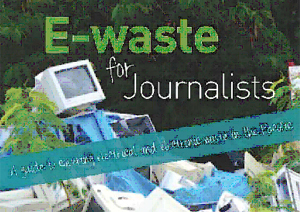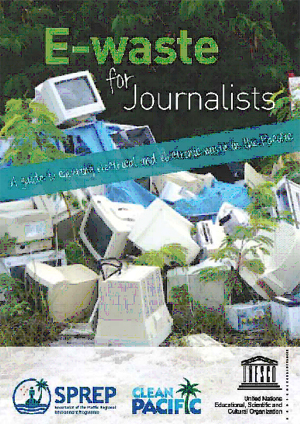
APIA (Secretariat of the Pacific Regional Environment Programme / Pacific Media Watch): A guide to help Pacific reporters produce news items on electronic and electrical waste (e-waste) in the Pacific is now available.
The E-waste for Journalists guide was produced by the Secretariat of the Pacific Regional Environment Programme (SPREP) with the support of the United Nations Educational, Scientific and Cultural Organisation (UNESCO).
E-waste is electrical and electronic equipment which is at the end of its useful life. This covers home or business items that use power, some examples of which are televisions, radios, computers, phones and digital cameras.
Pacific Island communities now face growing challenges from the impacts of e-waste.
“SPREP fully understands the value of Pacific media to help raise awareness and understanding of local communities, hence the development of this E-waste guide for reporters,” said the Director-General of SPREP, David Sheppard.
“It is through this publication that we hope to see more information being shared about e-waste, which in turn will lead to a better informed community that brings about positive actions to achieve a more sustainable future.”
“This guide will strengthen the media to be prepared for awareness-raising on e-waste at national and local level. Informed communities on e-waste are especially needed in the vulnerable environment of Pacific States. Knowledge on e-waste can be seen as one element towards sustainable development,” said the UNESCO Director for the Pacific States, Dr Visesio Pongi. The publication covers a range of key areas that are impacted by climate change. These are:
The publication covers a range of key areas that are impacted by climate change. These are:
- What is e-waste?
- Legal implications of e-waste;
- Social implications of e-waste; -
- Economic implications of e-waste;
- Health implications of e-waste;
- Environment implications of e-waste;
- and a case study on the first Cook Islands e-waste day.
The guide also contains activities for the news room to carry out to increase personal understanding as well as to help explore different story ideas.
All activities within the guide can be adapted to suit different learning methods, whether it is for an internal training session for a Pacific newsroom taught by the head of a news room, or individual learning by reporters that have a personal interest in this issue.
“Through much discussion with Pacific news reporters, we prepared this guide to meet their needs. We wanted to ensure that it works for our Pacific newsrooms and will not be stored on a shelf to sit unused,” said Nanette Woonton the Media and Public Relations Officer at SPREP.
“We are grateful for the support and vision of UNESCO in developing this guide to help benefit our Pacific media and the wider community in turn.”
To obtain a hard copy of the guide please contact Nanette Woonton at: nanettew@sprep.org
To download your electronic version please visit here.

This work is licensed under a Creative Commons Attribution-NonCommercial 3.0 New Zealand Licence.



